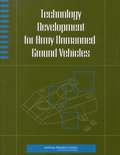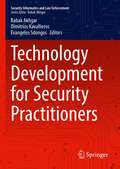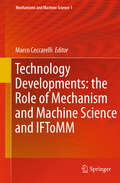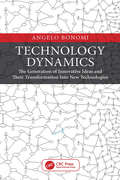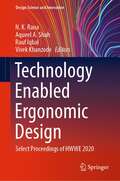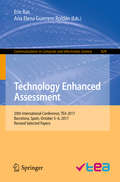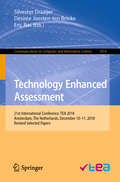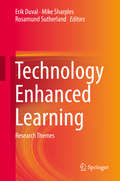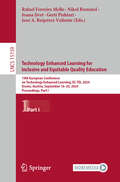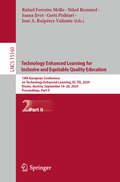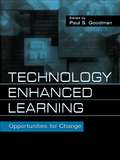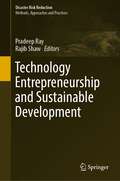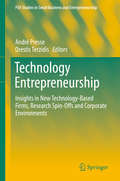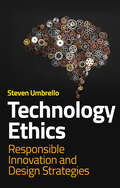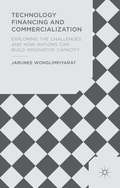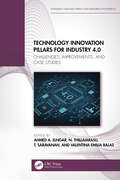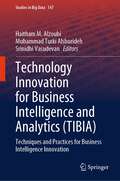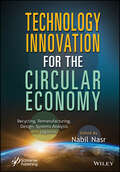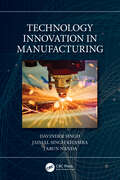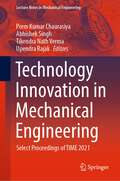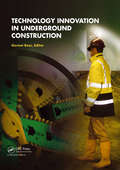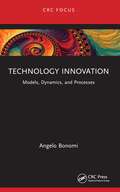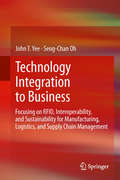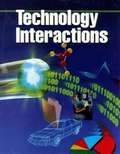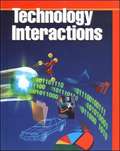- Table View
- List View
Technology Development for Army Unmanned Ground Vehicles
by Committee on Army Unmanned Ground Vehicle TechnologyUnmanned ground vehicles (UGV) are expected to play a key role in the Army’s Objective Force structure. These UGVs would be used for weapons platforms, logistics carriers, and reconnaissance, surveillance, and target acquisition among other things. To examine aspects of the Army’s UGV program, assess technology readiness, and identify key issues in implementing UGV systems, among other questions, the Deputy Assistant Secretary of the Army for Research and Technology asked the National Research Council (NRC) to conduct a study of UGV technologies. This report discusses UGV operational requirements, current development efforts, and technology integration and roadmaps to the future. Key recommendations are presented addressing technical content, time lines, and milestones for the UGV efforts.
Technology Development for Security Practitioners (Security Informatics and Law Enforcement)
by Babak Akhgar Dimitrios Kavallieros Evangelos SdongosThis volume is authored by a mix of global contributors from across the landscape of academia, research institutions, police organizations, and experts in security policy and private industry to address some of the most contemporary challenges within the global security domain. The latter includes protection of critical infrastructures (CI), counter-terrorism, application of dark web, and analysis of a large volume of artificial intelligence data, cybercrime, serious and organised crime, border surveillance, and management of disasters and crises. This title explores various application scenarios of advanced ICT in the context of cybercrime, border security and crisis management, serious and organised crime, and protection of critical infrastructures. Readers will benefit from lessons learned from more than 30 large R&D projects within a security context. The book addresses not only theoretical narratives pertinent to the subject but also identifies current challenges and emerging security threats, provides analysis of operational capability gaps, and includes real-world applied solutions.Chapter 11 is available open access under a Creative Commons Attribution 3.0 IGO License via link.springer.com.
Technology Developments: the Role of Mechanism and Machine Science and IFToMM
by Marco CeccarelliThis is the first book of a series that will focus on MMS (Mechanism and Machine Science). This book also presents IFToMM, the International Federation on the Promotion of MMS and its activity. This volume contains contributions by IFToMM officers who are Chairs of member organizations (MOs), permanent commissions (PCs), and technical committees (TCs), who have reported their experiences and views toward the future of IFToMM and MMS. The book is composed of three parts: the first with general considerations by high-standing IFToMM persons, the second chapter with views by the chairs of PCs and TCs as dealing with specific subject areas, and the third one with reports by the chairs of MOs as presenting experiences and challenges in national and territory communities. This book will be of interest to a wide public who wish to know the status and trends in MMS both at international level through IFToMM and in national/local frames through the leading actors of activities. In addition, the book can be considered also a fruitful source to find out "who's who" in MMS, historical backgrounds and trends in MMS developments, as well as for challenges and problems in future activity by IFToMM community and in MMS at large.
Technology Dynamics: The Generation of Innovative Ideas and Their Transformation Into New Technologies
by Angelo BonomiWhile science and technology research, sources of funding, performance, incentives, and motivations for technology innovation activities are reasonably well understood by academics and policy makers, the complex process by which scientific results are exploited and transformed into new technologies through an innovation process is poorly documented and studied little. Technology Dynamics is dedicated to the complex activity of technology innovation, with the aim of describing how innovative ideas are generated and their transformation into new technologies. It is based on the idea that technology evolves continuously with time, is changed by innovations, and is characterized by a dynamic that is constituted by technological processes occurring in organizational structures, as well as during the use of technologies. The five chapters Discuss technological processes for innovation; Describe innovation within organizational structures; Offer information on interfacing of science and economic factors with technology; Suggest new statistical studies for innovation and new approaches for innovation policies; and Examine the contribution of technology dynamics to statistical studies and promotion of technology innovation. This book is aimed at managers developing strategies for technology innovation, researchers interested in exploiting scientific results for innovative ideas and new technologies, scholars and students studying the economics of innovation. The book would also of interest to private or public financiers of innovation and policy makers involved in economic growth strategy.
Technology Enabled Ergonomic Design: Select Proceedings of HWWE 2020 (Design Science and Innovation)
by Rauf Iqbal Vivek Khanzode N. K. Rana Aqueel A. ShahThis volume presents selected papers presented during the 18th International Conference on Humanizing Work and Work Environment (HWWE 2020). The book presents research findings on different areas of ergonomics for developing appropriate tools and work environment considering capabilities and limitations of working people for maximum effectiveness on their performance. The book is divided into several sections focusing on different ergonomic research activities currently being undertaken at both national and international levels. The volume will be of use to researchers, practitioners and students working in different fields of ergonomics.
Technology Enhanced Assessment: 20th International Conference, Tea 2017, October 5-6, 2017, Barcelona, Spain (Communications In Computer And Information Science #829)
by Eric Ras Ana Elena Guerrero RoldánThis book constitutes the proceedings of the 20th International Conference on Technology Enhanced Assessment, TEA 2017, held in Barcelona, Spain, in October 2017. The 17 papers presented were carefully selected from 42 submissions. They are centered around topics like e-learning, computer-assisted instruction, interactive learning environments, collaborative learning, computing education, student assessment.Chapter "Student perception of scalable peer-feedback design in Massive Open Online Courses" is licensed under the terms of the Creative Commons Attribution 4.0 International License (http://creativecommons.org/licenses/by/4.0/). For further details see license information in the chapter.
Technology Enhanced Assessment: 21st International Conference, TEA 2018, Amsterdam, The Netherlands, December 10–11, 2018, Revised Selected Papers (Communications in Computer and Information Science #1014)
by Desirée Joosten-ten Brinke Eric Ras Silvester DraaijerThis book constitutes the proceedings of the 21st International Conference on Technology Enhanced Assessment, TEA 2018, held in Amsterdam, The Netherlands, in December 2018. The 14 papers presented were carefully selected from 34 submissions. They are centered around topics like e-learning, computer-assisted instruction, interactive learning environments, collaborative learning, computing education, student assessment.
Technology Enhanced Learning
by Erik Duval Rosamund Sutherland Mike SharplesThis book provides an overview of the state-of-the-art in Technology Enhanced Learning (TEL). It is organized as a collection of 21 clusters or research themes, each introduced by leading experts and including references to the most relevant literature on the theme of each cluster. Additionally, four seminal papers on each theme are included with expert commentaries and updates. This volume is of high value to the TEL community, a large and active group of multidisciplinary researchers, to contextualize the field and define it as a distinct research area.
Technology Enhanced Learning for Inclusive and Equitable Quality Education: 19th European Conference on Technology Enhanced Learning, EC-TEL 2024, Krems, Austria, September 16–20, 2024, Proceedings, Part I (Lecture Notes in Computer Science #15159)
by Ioana Jivet Rafael Ferreira Mello Nikol Rummel Gerti Pishtari José A. Ruipérez ValienteThe two-volume set LNCS 15159 and 15160 constitutes the proceedings of 19th European Conference on Technology Enhanced Learning, EC-TEL 2024, which took place in Krems, Austria, in September 2024. The 37 full papers, 25 poster papers, and 10 demo papers presented in the proceedings were carefully reviewed and selected from 140 submissions for research papers, and 26 poster and 19 demo submissions. They focus on effective technology adoption in educational settings, ethical concerns, and the possible digital divide these technologies could create. The theme for the 2024 conference aimed to explore the role of Technology-Enhanced Learning (TEL) in this critical context and in achieving the United Nations’ Sustainable Development Goal for education: “Ensure inclusive and equitable quality education and promote lifelong learning opportunities for all.”
Technology Enhanced Learning for Inclusive and Equitable Quality Education: 19th European Conference on Technology Enhanced Learning, EC-TEL 2024, Krems, Austria, September 16–20, 2024, Proceedings, Part II (Lecture Notes in Computer Science #15160)
by Ioana Jivet Rafael Ferreira Mello Nikol Rummel Gerti Pishtari José A. Ruipérez ValienteThe two-volume set LNCS 15159 and 15160 constitutes the proceedings of 19th European Conference on Technology Enhanced Learning, EC-TEL 2024, which took place in Krems, Austria, in September 2024. The 37 full papers, 25 poster papers, and 10 demo papers presented in the proceedings were carefully reviewed and selected from 140 submissions for research papers, and 26 poster and 19 demo submissions. They focus on effective technology adoption in educational settings, ethical concerns, and the possible digital divide these technologies could create. The theme for the 2024 conference aimed to explore the role of Technology-Enhanced Learning (TEL) in this critical context and in achieving the United Nations’ Sustainable Development Goal for education: “Ensure inclusive and equitable quality education and promote lifelong learning opportunities for all.”
Technology Enhanced Learning: Opportunities for Change
by Paul S. GoodmanThis book focuses on how technology may create new learning environments and enhance basic learning processes. The book identifies and informs some of the strategic decisions involved in designing and implementing new technology to enhance learning. It also examines specific learning applications of TEL in order to understand the context of different learning environments, as well as some of the critical lessons learned in designing these environments. Mixing both conceptual perspectives and actual case experiences should create different learning opportunities for the reader. Technology Enhanced Learning is divided into two parts. Part I deals with strategic issues, such as trends in technology, implications for educational systems, designing infrastructure, and learning environments. Part II looks at specific cases of new learning environments to learn about strategy, infrastructure, impact assessment, and change in TEL learning environments.
Technology Entrepreneurship and Sustainable Development (Disaster Risk Reduction)
by Rajib Shaw Pradeep RayThis book discusses the need for entrepreneurship for sustainable development from the perspective of Asia, the fastest growing region in the world. The world is now witnessing a spectacular rise of technology entrepreneurship, involving mobile phones, artificial intelligence, geospatial information systems and social media. On the other hand, governments all over the world, particularly those in low and medium income countries, are facing severe resource constraints in developing the livelihood and well-being of citizens. Although many non-government organizations (NGOs) have worked on various development projects in a number of social sectors such as health, education, disabilities, poverty alleviation and environment, there is still substantial scope for technological innovation, including more efficient, effective and user-friendly solutions in different parts of the world. This book is organized into 2 parts and consists of 17 chapters. The first part explores education and well-being, and the second part discusses the climate, environment and disaster management.
Technology Entrepreneurship: Insights In New Technology-based Firms, Research Spin-offs And Corporate Environments (Fgf Studies In Small Business And Entrepreneurship Ser.)
by André Presse Orestis TerzidisThis collection of expert articles explores the development drivers of new technology-based firms and projects. It provides perspectives for an in-depth understanding of how technological inventions lead to the creation of new and sustainable companies or business units. The authors address methods and concepts that help technology-based start-ups and entrepreneurial projects successfully develop innovative products and services.
Technology Ethics: Responsible Innovation and Design Strategies (Philosophy Of Engineering And Technology Ser. #40)
by Steven UmbrelloTechnologies cannot simply be understood as neutral tools or instruments; they embody the values of their creators and may unconsciously reinforce systematic patterns of inequality, discrimination, and oppression.Technology Ethics shows how responsible innovation can be achieved. Demonstrating how design and philosophy converge, the book delves into the intricate narratives that shape our understanding of technology – from instrumentalist views to social constructivism. Yet, at its core, it champions interactionalism as the most promising and responsible narrative. Through compelling examples and actionable tools, this book unravels the nuances of these philosophical positions tailored to foster responsible innovation and thoughtful design. As our everyday lives further intertwine with technology, understanding and implementing these design principles becomes not just beneficial, but essential.This concise and accessible introduction is essential reading for students and scholars of philosophy of technology, engineering ethics, science and technology studies, human-machine communication, as well as policymakers.
Technology Financing And Commercialization
by Jarunee WonglimpiyaratThis book offers insights on effective policies that can be applied to other economies in terms of using technology financing to foster technological innovations. It outlines the role of government in accelerating the nation's innovative capacity by promoting technology investments that will achieve successful and sustainable economic development.
Technology Innovation Pillars for Industry 4.0: Challenges, Improvements, and Case Studies (Intelligent Manufacturing and Industrial Engineering)
by Valentina Emilia Balas Ahmed A. Elngar N. Thillaiarasu T. SaravananTechnology Innovation Pillars for Industry 4.0: Challenges, Improvements, and Case Studies discusses the latest innovations in the application of technologies to Industry 4.0 and the nine pillars and how they relate, support, and bridge the gap between the digital and physical worlds we now live in.This book discusses each of the nine pillars and the roles they play in the rapid transformation of the design and operation, and offers applications and case studies supporting Industry 4.0 technologies. It presents the supply chain organizational activities utilizing cyber- physical systems architectures and talks about the advantages of intelligent manufacturing and the ability to proactively detect and respond to events, to improve quality and yield, reduce downtime, and lead to better overall equipment effectiveness among other advantages in smart factory operations.This reference book provides a great resource for undergraduate and graduate students, industrial and manufacturing engineers, and engineers of related disciplines along with business professionals, explaining what the nine pillars are and how they relate to Industry 4.0 and smart factories.
Technology Innovation for Business Intelligence and Analytics: Techniques and Practices for Business Intelligence Innovation (Studies in Big Data #147)
by Muhammad Turki Alshurideh Haitham M. Alzoubi Srinidhi VasudevanThis book provides a standpoint on how to effectively use technology innovation for business intelligence and analytics. It presents an approach that combines cutting-edge technological advancements with practical applications in the business world. The book covers a range of innovative technologies and how they can be applied to enhance business intelligence and analytics. It is primarily aimed at professionals in the business field data analysts and students studying subjects. This book is especially beneficial for those who want to grasp and apply the technological trends in making strategic business decisions. Its comprehensive coverage makes it an indispensable resource for anyone, in the intersection of technology and business analytics.
Technology Innovation for the Circular Economy: Recycling, Remanufacturing, Design, System Analysis and Logistics
by Nabil NasrTECHNOLOGY INNOVATION FOR THE CIRCULAR ECONOMY The book comprises 56 peer-reviewed chapters comprehensively covering in-depth areas of circular economy design, planning, business models, and enabling technologies. Some of the greatest opportunities for innovation in the circular economy are in remanufacturing, refurbishment, reuse, and recycling. Critical to its growth, however, are developments in product design approaches and the manufacturing business model that are often met with challenges in the current, largely linear economies of today’s global manufacturing chains. The conference hosted by the REMADE Institute in Rochester, NY, brought together U.S. and international researchers, industry engineers, technologists, and policymakers, to discuss the myriad intertwining issues relating to the circular economy. This book consists of 56 chapters in 10 distinct parts covering broad areas of research and applications in the circular economy area. The first four parts explore the system level work related to circular economy approaches, models and advancements including the use of artificial intelligence (AI) and machine learning to guide implementation, as well as design for circularity approaches. Mechanical and chemical recycling technologies follow, highlighting some of the most advanced research in those areas. Next, innovation in remanufacturing is addressed with descriptions of some of the most advanced work in this field. This is followed by tire remanufacturing and recycling, highlighting innovative technologies in addressing the volume of end-of-use tires. Pathways to net-zero emissions in manufacturing of materials concludes the book, with a focus on industrial decarbonization. Audience This book has a wide audience in academic institutes, business professionals and engineers in a variety of manufacturing industries. It will also appeal to economists and policymakers working on the circular economy, clean tech investors, industrial decision-makers, and environmental professionals.
Technology Innovation in Manufacturing
by Jaimal Singh Khamba Davinder Singh Tarun NandaThis text identifies and discusses different technology innovation initiatives (TIIs) such as entrepreneurial capability, technology infrastructure capability, organizational culture and climate, and government initiatives. It further evaluates the relationship between various technology innovation initiatives and manufacturing performances using multi-criteria decision-making techniques such as fuzzy set theory (FST), structural equation modeling (SEM), and analytic hierarchy process (AHP). It will serve as an ideal reference text for graduate students and academic researchers in the field of industrial engineering, manufacturing engineering, mechanical engineering, automotive engineering. This book: • Discusses technology innovation initiatives such as entrepreneurial capability, technology infrastructure capability, and organizational culture. • Highlights technology innovation-strategy model in assisting manufacturing industries for enhancing their performance in today’s competitive environment. • Examines the effect of technology innovation initiatives on the performance of manufacturing industries. • Covers multi-criteria decision-making techniques such as fuzzy set theory, structural equation modeling, and analytic hierarchy process. • Explores the validation of fuzzy-based technology innovation model through structural equation modeling.
Technology Innovation in Mechanical Engineering: Select Proceedings of TIME 2021 (Lecture Notes in Mechanical Engineering)
by Abhishek Singh Tikendra Nath Verma Prem Kumar Chaurasiya Upendra RajakThis book comprises select papers presented at the conference on Technology Innovation in Mechanical Engineering (TIME-2021). The book discusses the latest innovation and advanced research in the diverse field of Mechanical Engineering such as materials, manufacturing processes, evaluation of materials properties for the application in automotive, aerospace, marine, locomotive and energy sectors. The topics covered include advanced metal forming, Energy Efficient systems, Material Characterization, Advanced metal forming, bending, welding & casting techniques, Composite and Polymer Manufacturing, Intermetallics, Future generation materials, Laser Based Manufacturing, High-Energy Beam Processing, Nano materials, Smart Material, Super Alloys, Powder Metallurgy and Ceramic Forming, Aerodynamics, Biological Heat & Mass Transfer, Combustion & Propulsion, Cryogenics, Fire Dynamics, Refrigeration & Air Conditioning, Sensors and Transducers, Turbulent Flows, Reactive Flows, Numerical Heat Transfer, Phase Change Materials, Micro- and Nano-scale Transport, Multi-phase Flows, Nuclear & Space Applications, Flexible Manufacturing Technology & System, Non-Traditional Machining processes, Structural Strength and Robustness, Vibration, Noise Analysis and Control, Tribology. In addition, it discusses industrial applications and cover theoretical and analytical methods, numerical simulations and experimental techniques in the area of Mechanical Engineering. The book will be helpful for academics, including graduate students and researchers, as well as professionals interested in interdisciplinary topics in the areas of materials, manufacturing, and energy sectors.
Technology Innovation in Underground Construction
by Gernot BeerThis richly-illustrated reference guide presents innovative techniques focused on reducing time, cost and risk in the construction and maintenance of underground facilities:A primary focus of the technological development in underground engineering is to ease the practical execution and to reduce time, cost and risk in the construction and mai
Technology Innovation: Models, Dynamics, and Processes
by Angelo BonomiTechnology Innovation discusses the fundamental aspects of processes and structures of technology innovation. It offers a new perspective concerning fundamentals aspects not directly involved in the complex relations existing between technology and the socio-economic system. By considering technology and its innovation from a scientific point of view, the book presents a novel definition of technology as a set of physical, chemical and biological phenomena, producing an effect exploitable for human purposes. Expanding on the general model of technology innovation by linking the model of technology, based on a structure of technological operations, with the models of the structures for technology innovation, based on organization of fluxes of knowledge and capitals, the book considers various technological processes and the stages of the innovation process. Explains a novel definition of technology as a set of physical, chemical and biological phenomena producing an effect exploitable for human purposes Discusses technology innovation as result of structures organizing fluxes of knowledge and capitals Provides a technology model simulating the functioning of technology with its optimization Presents a technology innovation model explaining the territorial technology innovation process Offers a perspective on the evolution of technology in the frame of an industrial platform network The book is intended for academics, graduate students and technology developers who are involved in operations management and research, innovation and technology development.
Technology Integration to Business
by Seog-Chan Oh John T. YeeToday's global business environments drive companies to be more technology dependent, and to remain competitive, firms need to introduce or adopt a new technology to business. In order to achieve a successful integration with maximum return on investment, companies need a systematic approach that accommodates a comprehensive course of action of technology integration. Technology Integration to Business - Practical Methods and Case Studies suggests a business-driven holistic approach of technology integration that consists of several steps. First, companies should examine the current state, issues, benefits, and obstacles of technology integration in conjunction with their competitive business strategy and operational capability. Second, firms should investigate new, emerging business technologies as to how those technologies can contribute to improve the business. Third, with the technology integration needs identified, companies should complete preparatory tasks before actual implementation, such as, business process analysis, technology assessment, technology provider investigation, business case development, and cost-benefit analysis. Fourth, because the nature of technology integration project involves many stakeholders in global locations, firms should use effective project management knowledge from project initiation, through planning, execution, control, to close. Students will learn real-world technology integration processes in industry settings and become more prepared for industrial careers. Practitioners will find thorough procedures and methods that are useful in practice to improve business performance. Realistic examples for manufacturing, logistics, and supply chain management application domains give the reader practical implications for the methods presented.
Technology Interactions
by Henry R. Harms Neal R. SwernofskyTechnology depends on design and problem solving. To complete a design or to solve a problem, you need resources. The chapters in this section will introduce you to the resources of technology. They will also show you how you can use these resources to create the tools you will need to solve problems. Design and problem solving are important in technology. They are also important in life.
Technology Interactions (2nd edition)
by Henry R. Harms Neal R. SwernofskyTechnology Interactions is the only text that supports any modular technology education program for grades 6-10. Hands-on activities, fascinating facts, problem-solving exercises and other features to help students understand and experience technology. Topics include computer animation, health technologies, robotics, lasers and fiber optics, and much more. Students apply technical principles to the solution of problems by actually designing and building projects. Learning experiences at the end of each chapter sharpen students' reasoning and analytical skills by utilizing their creativity. Problem-solving emphasis helps relate technology theory to real-world activities and problems. Linking to Mathematics, Science, and Communication activities build cross-curricular skills. Fascinating Facts provide interesting sidebars that relate to each chapter's content. Career Pages highlight the qualifications and employability skills needed for various occupations.
